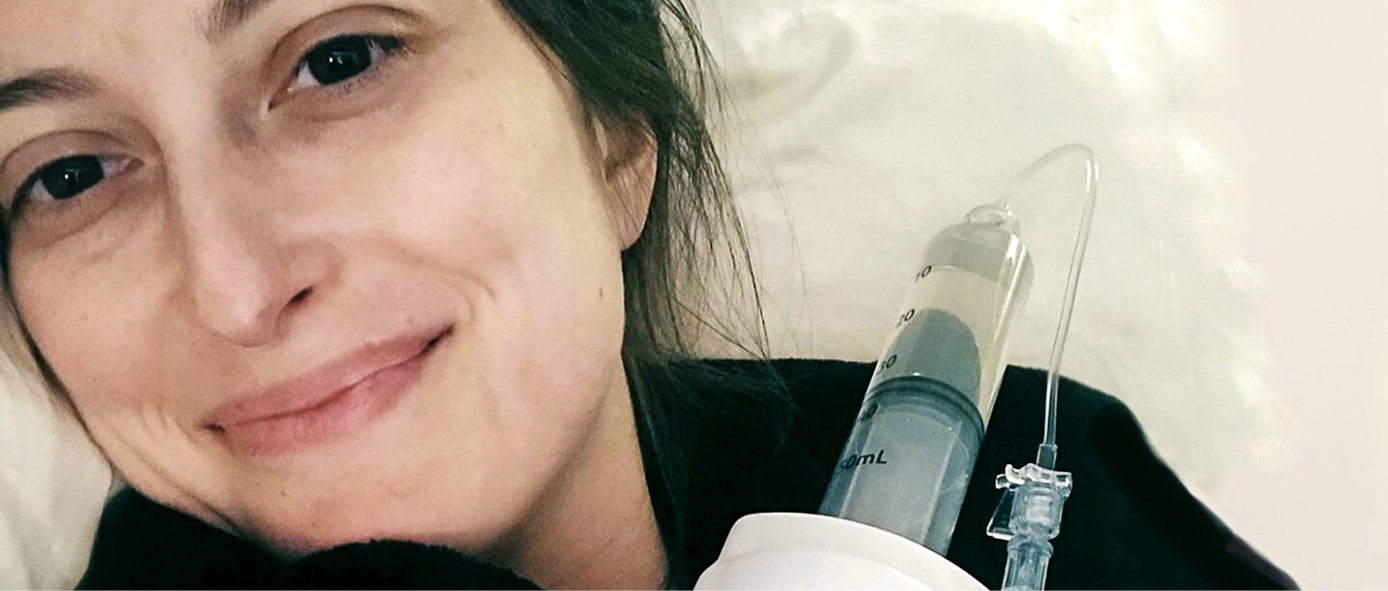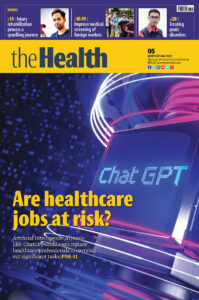For Myasthenia Gravis Awareness Month in June, discover more about the disease, learn how one woman lives with this rare autoantibody condition and why Johnson & Johnson is working to find new treatments for patients like her
Meridith O’Connor was only 10 years old when she started having trouble with her vision. “Every now and then things would get blurry, I’d see double or one of my eyelids would droop,” says the 31-year-old, who lives in St. Louis in the US.
Initially, doctors blamed allergies since her eyes were puffy and she had nasal congestion. But over the next few years, O’Connor’s symptoms grew more troubling. She began experiencing crushing fatigue, and she had difficulty chewing and swallowing.
“I was an active middle schooler playing volleyball, singing in a choir and taking dance lessons, but I was so tired and weak that I couldn’t keep up,” says O’Connor. Worse, some doctors suggested that her symptoms could be all in her head.
“I think they thought I was a lazy, depressed teenager. Even I started to wonder if I was imagining things, but deep down, I knew I wasn’t,” she said.

By 2005, the summer before O’Connor entered eighth grade, her symptoms were impossible to brush off. “My family and I were on vacation at the beach, but I was afraid to go into the ocean,” she says. “My facial muscles were so weak I couldn’t close my eyes or puff out my cheeks to hold my breath.”
When she began Googling her symptoms, what came up were two unfamiliar words—myasthenia gravis (MG) – attached to a scary description: a rare autoantibody disease that can cause the kind of widespread muscle weakness O’Connor had been experiencing. “It was a surreal moment,” she recalls. “I saw phrases like ‘rare disease’ and ‘no cure’ and I thought, ‘Could this really be it?’
O’Connor shared her internet findings with her pediatrician, who suspected MG despite O’Connor’s young age (MG can occur at any age, but onset of symptoms usually happens between the ages of 20 and 40).
O’Connor’s bloodwork confirmed her paediatrician’s suspicions: It showed high levels of antibodies attacking her muscles and interfering with their ability to contract. The news was upsetting – but also a relief. “It was like entering a new world,” says O’Connor. “My parents and I were terrified about what might happen to me, but I also felt validated. For the first time, I was being heard and believed.”
Now, thanks to a variety of treatments, O’Connor’s symptoms may still sap her energy, but they are largely under control. And while she has had to make sacrifices because of her fatigue, she hasn’t let that stop her from pursuing her dreams. Those dreams include getting married, earning a master’s degree in social work and building a career in patient advocacy.
“As someone who has a disease without any visible symptoms, I know what it’s like to have people think you’re exaggerating,” she says. “I want to help prevent others from going through that.”
Patients like O’Connor are why the Janssen Pharmaceutical Companies of Johnson & Johnson are committed to doing ground-breaking research for possible new treatments for people with rare autoantibody diseases like MG. For Myasthenia Gravis Awareness Month, we share five things we now know about the disease, along with potential promising new breakthroughs on the horizon.
1. Myasthenia gravis is rare, making it difficult to diagnose
It took O’Connor two long years to get the right diagnosis, and that kind of delay isn’t unusual. It takes most patients at least a year, according to a 2020 study in Neurology. That’s partly because the condition is relatively uncommon, affecting 36,000 to 60,000 people in the US and 700,000 people worldwide.
“The other issue that causes confusion is that muscle weakness – one of the hallmarks of the disease – can be a symptom of many other neurological conditions,” says Hong Sun, M.D., Ph.D., Senior Director, Global Compound Development Team Leader, Neuroscience at Janssen Research & Development.
That rings true to O’Connor. Initially, doctors thought she might have a different rare neuromuscular disorder similar to MG. Another issue that made her diagnosis tricky is that she was so young – only 10 years old – when her symptoms started. In women, symptoms of MG more typically start in their 20s; in men, symptoms are likelier to start in their 50s, according to a 2023 report in the Cleveland Clinic Journal of Medicine.
The first symptom, says Dr Sun, is typically an eye droop or other visual problem like double vision. Often, symptoms then progress to include difficulty swallowing, weakness in the arms, legs and neck and extreme fatigue. The condition can also interfere with a person’s ability to breathe. “We call that a ‘myasthenia crisis,’ where patients have to be intubated,” says Dr Sun.
Another characteristic of the condition is that symptoms tend to get worse as the day goes on. People with MG “may feel better when they first wake up, but the more they use their muscles, the more fatigued they get,” says Dr Sun.

In order to function optimally, O’Connor naps when her schedule allows and takes breaks throughout the day. “And if I don’t get nine hours of sleep a night, my eyelids droop,” she says (as shown in photo). “My life is guided by my health; it’s all about listening to my body and constantly adapting to what it needs because those needs are always changing.”
2. Myasthenia gravis is an autoantibody disease, which means the immune system turns on itself
When the immune system functions normally, it attacks foreign invaders, keeping us healthy. With MG and other autoantibody diseases, “something goes wrong with the surveillance system—that is, the immune system—and the body begins to develop autoantibodies attacking itself,” says Dr Sun.
One sign that O’Connor had MG was that her blood test results revealed high levels of autoantibodies attacking a protein known as acetylcholine receptor (AChR), located on the muscle membrane of a particular site called the neuromuscular junction. “AChR is a critical protein that normally binds with a chemical messenger called acetylcholine (ACh), triggering muscle contraction,” says Dr Sun.

“When the receptors are bound by autoantibodies, not enough ACh binds to trigger normal muscle contractions. In MG, this disrupted communication between the nerves and muscle result in muscle weakness and other tell-tale symptoms.”
With MG, however, the autoantibodies interfere with that process, disrupting communication between the nerves and the muscle, resulting in muscle weakness and other tell-tale symptoms.
3. There is no cure for myasthenia gravis, but surgery and medication can make a difference
After her diagnosis, O’Connor was hospitalised during spring break of her eighth-grade year. She underwent a procedure known as plasmapheresis, along with intravenous immunoglobulin therapy, a process designed to remove the offending antibodies from her bloodstream and replace them with “good” immunoglobulin antibodies. The procedure is “very invasive and time-consuming, and tends to be used when patients are at risk for an MG crisis,” says Dr Sun.
In O’Connor’s case, the procedure was done to help prepare her for surgery to remove her thymus gland, which is thought to generate the offending rogue immune cells. “Normally, the thymus gland tends to be bigger when we’re children, but shrinks once we get older,” says Dr Sun.
In some 50 to 70 per cent of patients with MG, however, the gland can become enlarged (called thymic hyperplasia) and another 10 per cent develop tumours on the thymus gland. “Surgery to remove the thymus can improve symptoms over the long term,” says Dr Sun.
Indeed, a 2019 study in The Lancet Neurology found that people with MG who had their thymus gland removed showed significant improvement in their symptoms after three years. “The thymectomy definitely helped me, but it wasn’t enough,” says O’Connor. “I was still experiencing symptoms.”

In addition to the muscle stimulants she was already taking, her physician prescribed steroids to tamp down her overactive immune system. “I have a love-hate relationship with steroids,” O’Connor says. “They have significantly improved my symptoms, but the side effects are incredibly debilitating.”
Says Dr Sun: “We’ve used these immunosuppressive drugs [i.e., steroids] for years, but they can cause adverse effects on blood pressure, cardiovascular health and bone marrow density.” For O’Connor, taking the medication twice a week versus every day or every other day and tapering the dose has made a positive difference.
4. New potential treatments are on the horizon
One problem with current immunosuppressive medications is that they suppress the entire immune system, making people with autoimmune disorders vulnerable to infection, as well as other problems. But a new treatment being investigated by researchers at Janssen is believed to act more selectively, blocking a protein called FcRn which, in turn, potentially helps lower the level of dangerous autoantibodies so muscles can function more normally.
“The investigational therapy is almost like a portable plasmapheresis machine in that it is believed to remove the pathogenic autoantibodies from the bloodstream, only it does it more quickly and easily,” says Dr Sun.

“It’s not a cure. But, so far, trials are showing that it gets to the cause of the problem in a very targeted and effective way, and it has demonstrated a safety profile that supports further development of the treatment.”
5. Myasthenia gravis is not yet a household word, but it’s on more people’s radar
With more effective treatments and promising new therapies in the pipeline, the future for people with MG is looking brighter every day.
As for O’Connor, with her most troubling symptoms under control, she is feeling happy and hopeful. “I’m getting married in July of 2024,” she says. “My mother likes to say it will be more than just a wedding. It’s a celebration of how far I’ve come, and it feels wonderful.” – The Health
This article appeared recently on the website of Johnson & Johnson








